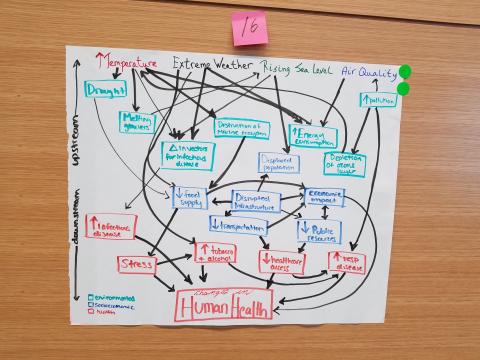Environmental and occupational factors have a major impact on the health of individuals, communities, and society and are a significant social determinant of health. The Institute of Medicine (IOM) has issued numerous reports indicating that there has been no or minimal inclusion of environmental and occupational health (EOH) topics in the curriculum of US medical schools. A major emphasis of the Swetland Center has been to integrate environmental health and community systems science into medical and graduate education to train the next generation of physicians and public health workers.
In 2016, environmental health science was introduced into the Case Western Reserve University School of Medicine (CWRU) curriculum in Block 1 (1st five weeks of medical school) by sequentially introducing EOH learning objectives in a developmentally appropriate order focusing on student-focused, self-directed learning. Evaluation of this project found that problem-based learning facilitated the inclusion of new EOH content in a pre-clerkship curriculum leading to the achievement of students’ cognitive objectives, positive attitudes, and improved confidence in environmental health science topics.
EOH topics were incorporated into the remaining pre-clinical problem-based learning curriculum in the first 2 years of medical school. Environmental and worksite visits have been incorporated into Block 1. Students get firsthand experience in the issues surrounding exposures and subsequent health issues and learn from community members and workers.
There continues to be the development of EOH curriculum in the problem-based learning cases in the third clinical year. In conjunction with the leadership of Block 8, there was an expansion student’s clinical experience with taking a patient’s EOH history, incorporating environmental and occupational factors in differential diagnoses, communicating EOH topics to patients, and developing treatment plans of environmental and occupational factor-related illnesses.
In 2019, a Team-Based Learning (TBL) exercise was added to the curriculum to teach medical students about Climate Change and Population Health. The students developed concept maps on the link between the environmental changes such as extreme weather and worsening air quality and health effects and debated population-based policy solutions that addressed up-stream causes of climate change.
Publication:
Garg A and Mulloy KB. (August 2018) Developing a Problem-Based Learning Approach to the Integration of Environmental and Occupational Health Topics into Medical School Curriculum. Journal of Occupational and Environmental Medicine. Journal of Occupational and Environmental Medicine. https://journals.lww.com/joem/Fulltext/2018/08000/Developing_a_Problem_Based_Learning_Approach_to.12.aspx
Abstracts:
1. Mulloy KB, Garg A. “Integrating Occupational and Environmental Health Science into Medical School Curriculum”. CWRU Research Day, Cleveland, OH, April 21, 2017.
2. Mulloy KB, Garg A. “Integrating Occupational and Environmental Health Science into Medical School Curriculum”. CWRU School of Medicine Education Retreat, Cleveland, OH, April 27, 2017.
3. Garg A, Mulloy KB. “Integrating Environmental Health Science into Medical School Curriculum.” Annual Meeting International Association of Medical School Educators, Burlington, VT, June 13, 2017.
4. Garg A, Mulloy KB. “Integrating Environmental Health Science into Medical School Curriculum.” Annual Meeting American Public Health Association, Atlanta, GA, November 4-8, 2017.
The Swetland Center for Environmental Health is committed in providing training in environmental health sciences to advance environmental health equity in the communities it serves. The Swetland Center in conjunction with Cleveland State University School of Nursing instituted training in environmental health sciences in the Community Health Worker Program in 2018.
Community Health Workers (CHW) are an integral part of work in the communities to improve health outcomes in the population. The American Public Health Association (APHA) has defined a CHW as “a frontline public health worker who is a trusted member of and/or has an unusually close understanding of the community served. This trusting relationship enables the worker to serve as a liaison/link/intermediary between health/social services and the community to facilitate access to services and improve the quality and cultural competence of service delivery. Community health workers also build individual and community capacity by increasing health knowledge and self-sufficiency through a range of activities such as outreach, community education, informal counseling, social support, and advocacy.”
The training included topics such as: the influence of the environment & environmental agents on human health based on knowledge of relevant epidemiologic, toxicological, & exposure factors; how environmental and occupational health function as a social determinant of health; and how to elicit an environmental exposure history, including a work history, from all patients.
The Swetland Center continues to work with CSU and the CHWs in training opportunities.


